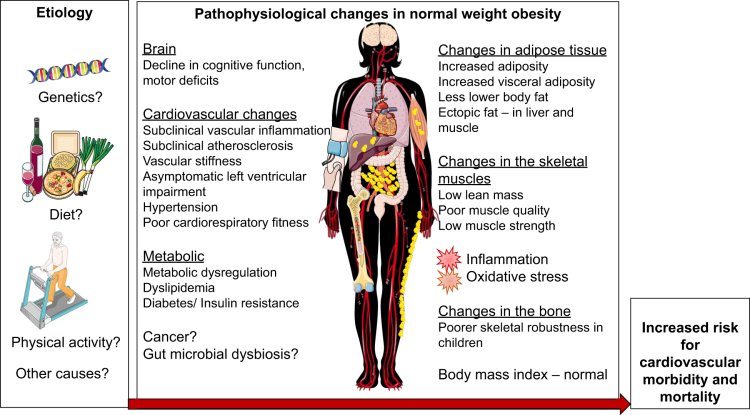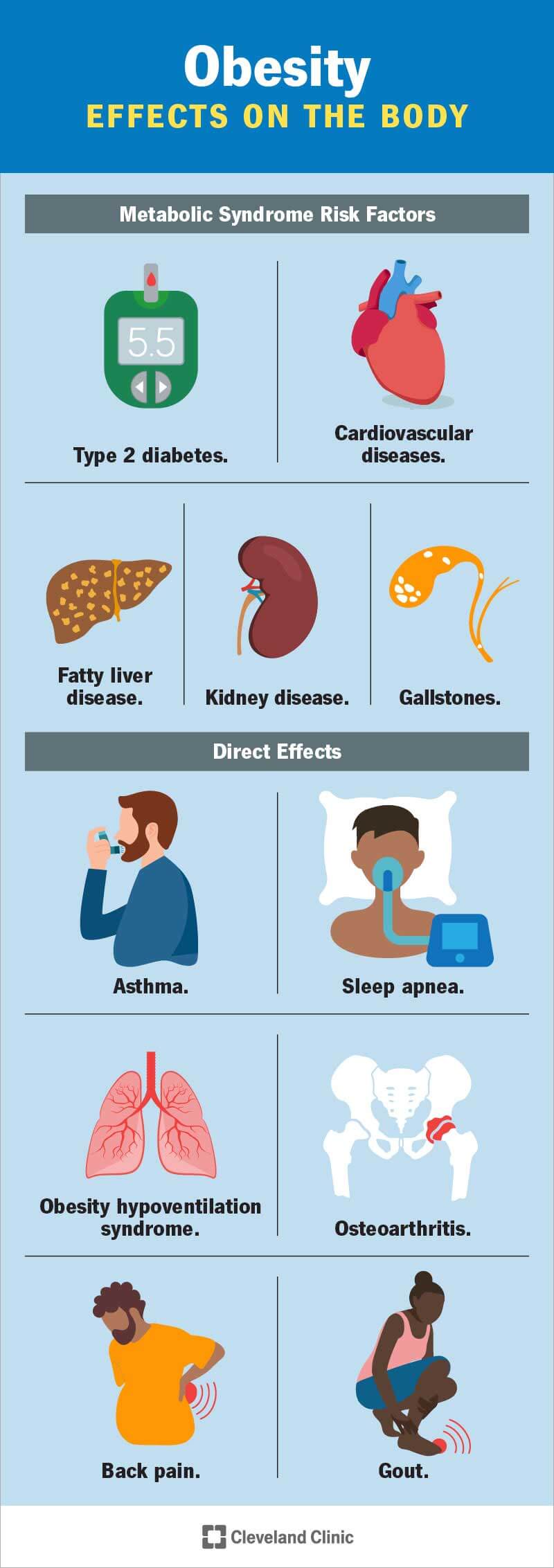What is obesity?
Obesity is commonly defined as having too much body mass. A BMI of 30 or higher is the usual benchmark for obesity in adults.

Obesity
Being overweight is a typical definition of obesity. Obesity in humans is often defined as a body mass index (BMI) of 30 or greater. Extreme (formerly "morbid") obesity is defined as a body mass index (BMI) of 40 or greater. Growth charts are used to assess the prevalence of childhood obesity.
What is obesity?
Excessive body fat and poor health can result from obesity, a complicated, chronic disease with multiple contributing factors. Naturally, being overweight is not a medical condition. However, too much fat in the body might alter its normal functioning. These alterations are chronic, worsening, and potentially harmful to one's health.
The good news is that reducing your overall body fat can help your health tremendously. The effects of weight gain or loss, no matter how slight, can be significant. There isn't a silver bullet for weight loss. Most people have made multiple attempts to reduce their weight. Keeping the weight off is equally as crucial as losing it.
Is obesity defined by your weight?
The Body Mass Index (BMI) is extensively used by medical professionals to classify patients as obese or overweight. The BMI is a calculation based on one's weight and height. Obesity is often defined as a body mass index (BMI) of 30 or greater by medical professionals. Despite its shortcomings, body mass index (BMI) is a simple metric that can assist draw attention to the dangers of obesity.
Bodybuilders and athletes are two examples of people who may have a higher BMI despite having a low body fat percentage because they have more muscle than the average person. It is also possible to be of "normal" weight and still be obese. It is possible to have the same health risks as someone with a higher BMI even if their weight is normal but their body fat percentage is high.
In addition, doctors have noticed that patients of different races have varying upper weight limits before their health begins to suffer. Health hazards, for instance, are more common in persons of African origin at higher body mass indexes and in people of Asian descent at lower BMIs.
Waist circumference measurements are another method used to diagnose obesity. You are statistically more likely to develop a condition associated with obesity if you have a larger waist circumference. When your waist circumference is greater than 35 inches for those who were born female and 40 inches for those who were born male, the danger increases significantly.
What are the three types of obesity?
Obesity is categorised by the severity with which healthcare professionals treat it. Body mass index is used. If your body mass index (BMI) is between 25.0 and 29.9, you are considered overweight. Healthcare providers typically categorise patients with obesity into one of three broad categories to determine the most appropriate course of therapy. Among them are:
- Class I obesity: BMI 30 to <35 kg/m².
- Class II obesity: BMI 35 to <40 kg/m².
- Class III obesity: BMI 40+ kg/m².
What is “morbid” obesity?
The term "morbid obesity" is now considered to be an archaic way of referring to obesity of class III severity. The term "morbidity" refers to potential health problems. Class III obesity, which is associated with a high risk of developing serious health complications, earned the label "morbid" from medical professionals. However, due to its pejorative implications, they no longer use the phrase.
How is childhood obesity assessed?
Obesity in children is measured using BMI, however this time the calculation takes into account the child's age and gender. If a child is older than 2 years and has a body mass index (BMI) that is larger than 95% of their peers in the same group, a diagnosis of childhood obesity may be made. Depending on the population they represent, some growth charts may have slightly different BMI averages than others.
How common is obesity?
Adult obesity in the United States was last measured in 2017–2018. The rate increased from 1999-2000's 30% to this year's 42.5. Class III obesity rates roughly doubled over that time, from 4.7% to 9.2%. In 2017–2018, 19.3% of American children were obese.
The prevalence of obesity has nearly tripled during the past half century. This increase has been striking in low-income nations where malnutrition is widespread. The availability of high-calorie, low-nutrient foods in these areas has increased. Now, undernourishment and obesity are both rampant in these regions.
How does obesity affect my body?
There are numerous physical manifestations of obesity. Some of them arise automatically from carrying around extra weight. It's easy to see how carrying around additional weight puts strain on your bones and joints. Subtle changes in your blood chemistry can increase your danger of developing diabetes, cardiovascular disease, and stroke.
The full extent of some impacts is still unclear. Obesity, for instance, has been linked to an uptick in the incidence of several cancers. No one can explain its existence, yet it does. Obesity is associated with an increased risk of dying at a younger age. Losing just 5 to 10 percent of your body weight has been shown to greatly reduce these hazards.
Metabolic changes
Your metabolism is the system by which your body turns food into the fuel it needs to function. When there are more calories in the body than the body needs, the excess calories are stored as lipids in the adipose tissue. When there is nowhere else for fat to be stored, fat cells expand. Increased fat cell size is associated with the release of inflammatory hormones and other substances.
The health repercussions of chronic inflammation are numerous. It has metabolic effects through, among other things, increasing insulin resistance. This implies your body is no longer able to effectively use insulin to decrease levels of glucose and lipids (fats and carbohydrates) in the blood. Elevated levels of glucose and lipids (cholesterol and triglycerides) in the blood also have a role in the development of hypertension.
The term "metabolic syndrome" is used to describe a cluster of health problems. They're included together because their effects are cumulative. They encourage even more weight gain and make it more challenging to reduce weight and keep it off. Several disorders are linked to obesity, and metabolic syndrome is a major contributor.
Diabetes type 2. The risk of developing Type 2 diabetes due to obesity increases by a factor of seven in those who are biologically male and by a factor of twelve in those who are biologically feminine. Every additional point on the body mass index scale raises the risk by 20%. Losing weight also helps reduce this.
Cardiovascular disorders. Coronary artery disease, congestive heart failure, heart attack, and stroke all share a common risk factor: high blood pressure, high cholesterol, high blood sugar, and inflammation. The higher your body mass index (BMI), the higher your risk. Both internationally and domestically, cardiovascular disease is the biggest preventable cause of mortality.
Toxic liver disease caused by excess fat. The liver, which is responsible for purifying the blood, eventually becomes saturated with the excess lipids that have been circulating throughout the body. The accumulation of fat in the liver can cause hepatitis and eventually cirrhosis if left unchecked.
Renal failure. Common causes of kidney failure include hypertension, diabetes, and liver disease.
Gallstones. Cholesterol gallstones and other gallbladder problems may form when excess cholesterol in the circulation finds its way into the gallbladder.
Direct effects
Having too much fat on your body can make it difficult to breathe and put undue strain on your muscles and joints. Because of this,
1. Asthma.
2. Apnea of sleep.
3. syndrome of obesity-related hypoventilation.
4. Osteoarthritis.
5. I have a bad back.
6. Gout.
Asthma.One-third of obese adults in the United States also suffer from arthritis, according data from the Centres for Disease Control and Prevention. The risk of developing knee arthritis increases by 36% for every 5 kilogrammes of weight gain, according to studies. The good news is that losing just 10% of your body weight, in conjunction with regular exercise, can considerably lessen arthritis-related discomfort and improve your quality of life.
Asthma.One-third of obese adults in the United States also suffer from arthritis, according data from the Centres for Disease Control and Prevention. The risk of developing knee arthritis increases by 36% for every 5 kilogrammes of weight gain, according to studies. The good news is that losing just 10% of your body weight, in conjunction with regular exercise, can considerably lessen arthritis-related discomfort and improve your quality of life.
Indirect effects
Indirectly, obesity is linked to:
1. Cognition and memory, including an increased vulnerability to Alzheimer's disease and other forms of dementia.
2. Problems in conception and carrying a baby to term in women.
3. Disorders of the mood and depression.
4. Cancers of the oesophagus, pancreas, colon, breast, uterus, and ovaries, among others.
What causes obesity?
Consuming more calories than your body burns off is the root cause of obesity. This is due to a number of causes. There are aspects of this that are unique to you. Some are institutionalised at the national, regional, or familial levels of our society. Preventing obesity may require a concerted effort against these various causes.
Factors that may increase calorie consumption include:
1. Fast and convenience foods
Quick and easy meals. It's easy to put on weight in neighbourhoods and households where fast food and other highly processed convenience foods are commonplace. These foods tend to increase hunger due to their high sugar and fat content and poor fibre and nutritional content. They include chemicals that trigger compulsive overeating. Because of price and availability, these foods may be the only ones available in some areas. According to the CDC, almost 40% of homes in the United States are more than a mile from supermarkets or other sources of healthful food.
2. Sugar is in everything.
There is sugar in everything. The commercial food system was not created with our health in mind. It's meant to get us hooked on the advertised goods so we'll keep buying them. Sweets and sugary drinks are at the top of this list despite their lack of nutritious benefit and high calorie content. Sugar is added to even commonplace meals to make them more palatable and addicting. Because of how widespread it is, it has altered our standards of good taste.
Marketing and advertising.
Promotion and marketing. Despite our lack of need, we are constantly bombarded with advertisements for processed foods, candies, and sugary drinks. Commercials portray these items as integral to one's way of life. The promotion of alcoholic beverages, which contain many empty calories, also plays a significant role in the market.
Psychological factors
Reasons relating to the mind. Overeating is a frequent response to emotional states including boredom, loneliness, anxiety, and despair, all of which are common in today's society. Particularly, they may cause us to overeat calorie-dense foods that stimulate our brain's reward circuitry. Eating to improve one's mood is as natural as breathing. Our ancestors had to work hard to find food for themselves, and evolution hasn't quite caught up to the kind of food surplus enjoyed by Western civilizations today.
Hormones.
Hormones. Our signals of hunger and fullness are controlled by hormones. These regulatory mechanisms are vulnerable to a wide range of disturbances, from the more common (stress, lack of sleep) to the less so (genetic variants). Hormones might keep you craving food even when you're already well-nourished. It's not always obvious when you've had enough of them.
Certain medications.
Some pharmaceuticals. Gaining weight might be a side effect of some of the medications you take for other issues. Included in this category are drugs used to treat depression, anxiety, seizures, diabetes, and hypertension, as well as beta-blockers.
Factors that may decrease how many calories we spend include:
Screen culture.
Media ethos. We spend more and more time in front of our phones and computers as more and more of our daily activities move online, including work, shopping, and socialising. Binge-watching and other forms of media streaming make it easier to sit for extended periods of time.
Workforce changes
Staffing shifts. More people today sit at desks than stand due to automation and computerization trends in the workplace. They put in extra time at work as well.
Fatigue.
Fatigue. The effects of leading a sedentary life tend to accumulate. The longer you sit for, the more tired and unmotivated you will feel, according to research. Stiffness and soreness in the body from prolonged sitting might be a deterrent to getting up and about. Fatigue is a side effect of the tension it creates.
Neighborhood design.
Constructing communities. There is a dearth of accessible and safe public spaces for physical activity for many people in their communities. In the United States, about 50% of the population does not have easy access to green space. It's possible that they don't live in areas that are conducive to walking, and that they don't have role models who are physically active. When other modes of transportation are unavailable, most individuals must rely on their personal automobiles.
Childcare trends.
The latest in child care. Children no longer spend as much time as they formerly did playing outside. They spend more time in stifling childcare settings that may not provide enough room or equipment for exercise. Cultural shifts have made it less acceptable for kids to play outside alone. It's partly because of a lack of convenient public gathering places and good child care options in the area. TV has replaced free play in many daycares.
Disability.
Disability. Obesity is more prevalent among adults and children with physical and learning difficulties. Physical restraints and an absence of sufficient specialised training and resources can play a role.
How is obesity diagnosed?
At your checkup, your doctor will take your vitals, including weight, height, and waist measurement.
In addition, when you visit a doctor for treatment, they will want to know the full scope of your health history. They will inquire as to any illnesses, medications, or recent changes in your weight. They will inquire about your current eating, sleeping, and exercising habits as well as your stress levels and previous attempts at weight loss. They may inquire as to the state of health of your biological family.
Your vital signs (heart rate, blood pressure, and an examination of your heart and lungs) will also be checked. Hormone imbalances, diabetes, and high cholesterol can all be detected with a simple blood test. Obesity and its associated disorders will be diagnosed with the help of this comprehensive profile.
How is obesity treated?
The specifics of your care will depend on your individual health history. Your doctor will address any immediate health problems you have before moving on to a strategy for permanent weight loss. It's possible they'll suggest a simple adjustment, like switching drugs, that will have a dramatic effect right away. The treatment strategy as a whole will be more gradual and comprise multiple components. Due to individual variation, you might need to try a few different treatments before you find the right one. The most effective methods for weight loss and maintenance have been found to be intensive, team-based programmes with frequent, personal communication between you and your provider.
Dietary changes
It's up to you to figure out what dietary adjustments work best for you and your weight loss goals. Reduced intake at each meal and between-meal snacks may be helpful for certain persons. Altering one's diet may be more important than reducing one's calorie intake for some people. Increasing one's plant intake is beneficial for nearly everyone. Low in fat and high in fibre and micronutrients, foods like fruits, vegetables, whole grains, and legumes are a healthy choice. They're healthier overall, and they might help you feel full on fewer calories.
Increased activity
Everyone knows that nutrition and exercise are crucial to getting and staying at a healthy weight. However, going to the gym isn't the only option for becoming in shape. One of the most effective forms of exercise for weight loss is just walking at a moderate speed. The recommendation from medical professionals is to exercise for only 30 minutes, five days a week. Taking a walk during lunchtime or before/after work every day can have a significant impact.
Behavioral therapies
You may find help on your weight loss journey through counselling, groups, and techniques like cognitive behavioural therapy. Using these techniques can aid in rewiring your brain to facilitate constructive alteration. They can also assist you in dealing with emotional and psychological obstacles, such as stress. As our weight and our attempts to lose it influence us on multiple levels, it helps to have emotional as well as logistical back up.
Medication
Your doctor may advise you to take medication in addition to other treatments. Medication can help attack the issue of obesity from a different perspective. Appetite suppressants are one type of medication that can work by blocking hunger signals before they reach the brain. This may be a minor detail for some, but crucial information for others.
Weight loss surgery
Class III obesity often warrants consideration for bariatric surgery. Surgery is a drastic method, but it can help you lose weight and keep it off for good. Instead of relying on mental discipline or behavioural modification, it alters your biological makeup. All forms of bariatric surgery involve some kind of change to the patient's digestive tract. They put limits on how many calories you can take in and process. They also alter hormones in the gut that influence metabolism and appetite.
Methods used in bariatric surgery include:
1. Sleeve gastrectomy, or the gastric sleeve.
2. Loss-of-appeal band (gastric).
3. Roux-en-Y gastric bypass surgery.
4. An adjustment made in the duodenum.
How can I prevent obesity?
Obesity is easier to cure in its early stages than it is to reverse once it has taken hold. When your body reaches a new, higher "set point," it uses that weight as its standard. Despite your best efforts, your body will always do all it can to keep your weight the same, including adjusting hunger signals and energy expenditure.
If you or your child has been putting on weight recently, especially if you have a history of obesity in your family, it's best to get on top of it as soon as possible. To avoid future obesity and weight reduction challenges, it is important to examine current routines and make sensible adjustments.
For example:
- Make a small sacrifice. Do you have a daily snack habit or “pick-me-up,” such as a sugary drink, that is high in calories? Consider replacing it. Just 150 extra calories a day can add up to 10 extra pounds in a year. That’s equal to a snack-size bag of potato chips, or just two double-stuffed Oreos.
- Add a small activity. Alternatively, consider what you might do to spend an extra 150 calories in a day. For example, go for a hike or use an elliptical machine for 25 minutes, or take the dog for a brisk walk for 35 minutes.
- Shop intentionally. Stock your home with healthy foods and save sweets and treats for special occasions when you go out. Whole foods are higher in fiber and lower on the glycemic index, so they don’t cause your blood sugar to spike and drop the way processed snacks and treats do.
- Cultivate overall wellness. Reduce your screen time, go outside and go for a walk. Manage your stress and try to get adequate sleep to keep your hormone levels in check. Focus on positive changes and healthy activities rather than how your efforts affect your weight.
What is the outlook for me if I have obesity?
There are a number of health problems that might arise as a result of being overweight. However, this does not imply that these conditions currently exist. And that doesn't imply you're powerless in the face of them. The dangers are real, yet they are also reversible or controllable. Your doctor will probably suggest that you shed some pounds to help. It won't be easy, but it's not impossible.
Keep in mind that even a little weight loss of 5-10% might have a major impact on your health. It can halt or reverse the development of metabolic syndrome, diabetes, and fatty liver disease. If you get help from a doctor, you can lose at least that much weight. Maintaining weight loss requires dedication to a long-term treatment strategy.
A note from Cleveland Clinic
You may have encountered the prejudice that views fat as a moral failing on the part of the individual. It's likely that you've already made numerous attempts to deal with your weight on your own before seeking professional help.
The good news is that there is growing hope for treating obesity thanks to medical discoveries. Taking control of your health is possible; it may take some trial and error to find the proper combination of treatments, but you can do this with the help of your healthcare practitioner. A small amount of weight loss can have far-reaching effects on your health, and adopting a healthier diet and way of life will pay dividends for the rest of your life.














